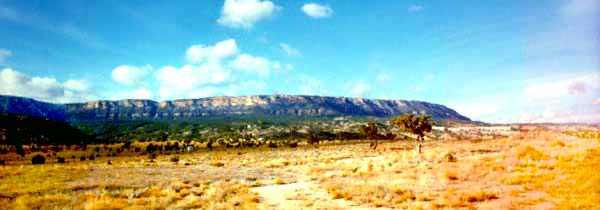

Black Mesa [Dzi![]() yíjiin]
is the dominant landscape feature over much of this area. It is a large structure of the
least eroded, and therefore the youngest, soil in this area.
It is capped by Mesa Verde sandstone which lies above much softer layers. Working down
from the top, these are a layer of very soft Mancos shale, the Morrison Formation, Dakota
sandstone and the San Rafeal group. The lower layers are being constantly eroded wher
they are exposed on the sides of the mesa, leading to landslides and constant valley
widening.
yíjiin]
is the dominant landscape feature over much of this area. It is a large structure of the
least eroded, and therefore the youngest, soil in this area.
It is capped by Mesa Verde sandstone which lies above much softer layers. Working down
from the top, these are a layer of very soft Mancos shale, the Morrison Formation, Dakota
sandstone and the San Rafeal group. The lower layers are being constantly eroded wher
they are exposed on the sides of the mesa, leading to landslides and constant valley
widening.
The Mancos Shale is the product of a Cretaceous era sea and contains fossils of marine shellfish such as ammonites and the skeletons of fish (including sharks), crocodiles, turtles and even pleiosaurs. The lagoon deposits are near the surface over most of the mesa and are the source of most of the coal that is currently being strip mined. In this process, the vegetation is removed, the top soil pushed aside, and the "overburden" ( as much as 180 feet!) is stripped away to get at the coal. Huge power shovels remove the coal which is crushed and carried by conveyor belt, slurry pipeline and railroad to power plants, such as those at Page and even in Nevada. Approximately 12 million tons of coal are mined annually. While royalties are paid to the Navajo and Hopi tribes, these royalties are paid at a rate determined 40 years ago and never adjusted. The royalties are currently less than 3% of the price received by Peabody Coal. The mining and transportation of this coal is also a serious drain on the water supply of the Hopi and Navajo tribes. The water table has been drastically lowered due to the mining. This is another issue to be renegotiated with Peabody Coal in the near future.

References
 |